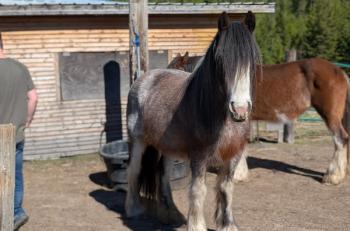
Thyroid disease in horses (Proceedings)
The thyroid gland is located in throat latch region below the larynx, the gland is bilobed, connected by a narrow isthmus.
Anatomy:
- Located in throat latch region below the larynx, the gland is bilobed, connected by a narrow isthmus.
Function:
- Secretes two significant hormones; thyroxine (T4) and triiodothyronine (T3)
Thyroid Hormone Formation:
- Thyroglobulin synthesized and stored in thyroid follicles.
- Iodine is "trapped" in thyroid and incorporated into thyroglobulin
- peroxidation results in formation of T4, T3, and rT3 most of the stored form is T4 (90%)
- T3 accounts for < 10%
Thyroid Hormone Metabolism:
- in circulation, 99% of T3 and T4 are bound to albumin
- only unbound or "free" fraction is metabolically active
- small portions of T4 slowly deiodinate to T3
- hormones enter cells by both passive and active mech.
- T3 is about five times more potent in stimulating metabolism than T4
- T4 exerts its effects five times longer than T3
Function:
- free T3 &4 bind to cell receptors and activate or repress transcription and synthesis of proteins and m-RNA
- these alterations in protein synthesis regulate observed effect of thyroid hormones [>metabolic rate, oxidative metabolism]
- decreased circulating free T4 stimulates hypothalamus to release TRH
- TRH stimulates anterior hypophysis to release TSH
- TSH increases all activities of thyroid gland
Thyroid system diagram
Function of Thyroid Hormones
- increase metabolic rate
- growth regulators
- cell differentiation
- oxidative metabolism
In general, thyroid hormones exert effect by binding to nuclear receptors and direct action on the genome to initiate DNA transcription and formation of new proteins
Low Concentrations of Thyroid Hormones:
- retarded growth
- increased sensitivity to cold
- delayed shedding of coat
- limb edema
- decreased food consumption
- fertility problems
Excess Thyroid Hormone
- rapid protein catabolism, protein stores mobilized
- tachycardia
- increased appetite
- weight loss
- excessive sweating
- heat intolerance
- goiter
Control of Free Thyroid Hormone
- Very sensitive mechanism
- increased T4 in circulation decreases secretion of TSH by anterior pituitary.
- feedback mechanism primarily effects pituitary but also acts on hypothalamus and TRH declines
During periods of heavy exercise or stress, thyroid hormone is consumed rapidly.
Feedback regulation- rate of secretion of thyroid hormone rises to equal consumption and blood thyroid levels remain constant
Hypothyroidism may result from abnormalities in formation, secretion, transport or metabolism of thyroid hormones.
- Primary; inadequate production of T3 & 4 from thyroid
- Secondary; deficiency of TSH from pituitary gland
- Tertiary; inadequate quantities of TRH from hypothalamus
In dogs and man primary hypothyroidism most common.
- thyroid gland does not respond to TSH
- little or no thyroid hormone released into circulation
Normal effects of age on thyroid hormone production-neonates >> aged animals
Euthyroid sick syndrome
Thyroid Disease in Foals
Hyperplastic goiter in neonates is the most common thyroid dysfunction in horses. Originally described in western Canada, increasing incidence in US
Etiology: dam ingests excess iodine during pregnancy
- kelp or feed supplements
- plant goitrogens (soybeans, turnips)
Equine placenta permeable to iodine and goitrogens, not T3 and T4
Hypothyroidism in foals may involve 2 separate clinical entities due to multiple actions of thyroid hormone (metabolic rate & cell differentiation).
- thyroid hyperplasia and musculoskeletal deformity (TH-MSD)
- congenital hypothyroidism and dysmaturity syndrome
I. hypometabolic- occurs with thyroid hormone inadequacy
II. developmental lesions- normal hormone levels indicating hormone deprivation during fetal development
Clinical Signs:
- gestation length prolonged (360 days)
- thyroid enlargement or goiter
- mandibular prognathia
- signs of prematurity (hair coat, lax tendons & joints)
- incoordination and poor suckling
- incomplete ossification of carpus and tarsus
Clinical Pathology:
- Baseline T3 and T4 levels are low or within normal range (*NB- compare values with other neonates)
- may be diminished response to TSH (only performed in limited number of foals)
- Levels will normalize over time regardless of supplementation
Etiology:
- Current theories suspect dietary deficiencies, toxicity or infectious agent.
- Selenium deficiency may play role
Foals have higher levels of circulating thyroid hormones than other species- may be more susceptible to effects of low levels of hormone
AJVR vol.56 January 1995
AJVR
- 1989; 24 pregnant mares 1990; 27 pregnant mares
- mean T3 concentration in foals exposed to endophyte (395 ng/ml) was decreased compared to control foals (778 ng/ml)
Treatment and Prognosis:
- largely supportive, splints, physical therapy and nutritional supplementation
- thyroid supplementation controversial... (may be ineffective)
- Prognosis varies with severity of lesions....orthopedic disease? septicemia?
Thyroid Disease in horses
Thyroid dysfunction has been the subject of debate and controversy in the veterinary community. Some researchers suggest that hypothyroidism is common while others insist that it is an uncommon endocrine disease.
Large numbers of broodmares and performance horses are receiving daily supplements of thyroid hormones.
Clinical Signs:
To most people, the typical hypothyroid horse is fat, with a cresty neck with laminitis.
Signs may include:
- anhidrosis
- infertility
- myositis
- agalactia
- poor growth
Experimentally thyroidectomized horses demonstrated: poor/no growth, hypothermia, lethargy, anemia, a dull hair coat & edema.
No horses developed laminitis or became obese, also, 2 mares became pregnant.
K. Donavan; The Blood Horse, February 1991
The Blood HorseJAVMA, vol 220, January 2002
JAVMA
- 329 clinically normal broodmares
- 60 mares on thyroid supplementation
- measure serum T4 concentration
- analysis indicated that serum T4 not related to preg.
- supplementation not indicated nor likely to be beneficial
Humans with hypothyroidism demonstrate decreased muscle strength and muscle cramps, cardiovascular problems...
Do we equate horses with myositis and poor performance with clinical hypothyroidism in humans ?
Performance horses with borderline T3 & 4 levels generally placed on thyroid supplements...
No controlled studies to validate this practice nor confirm association of thyroid levels with poor performance. [racetrack study????]
Few horses are actually "worked up" and at best, a single T3 & 4 determination is made.
In reality, these horses may have pituitary dysfunction, EMS or any number of other disorders that contribute to decreased thyroid levels.
Iatrogenic Hypothyroidism:
- high carbohydrate diets
- diets high in zinc and copper
- diets containing kelp and seaweed
- insufficient or excessive iodine intake
- goitrogenic plants (soybeans, cabbage, turnips)
- ingesting endophyte-infected fescue
Euthyroid Sick Syndrome:
- low circulating thyroid hormone concentrations resulting from a catabolic state.
- Chronic diseases including:
- starvation/malnutrition
- sepsis
- neoplasia
- chronic renal or hepatic disease
Additionally, certain drugs will decrease thyroid hormone concentrations including NSAID's and corticosteroids.
Horses with ESS will demonstrate a positive thyroid response following a TSH stimulation test.
A major diagnostic dilemma facing equine clinicians in euthyroid sick syndrome is whether the horse is truly hypothyroid or euthyroid.
Current diagnostic technology in equine medicine make this delineation virtually impossible.
Many horses with pituitary adenomas are frequently diagnosed as hypothyroid when in fact they have ESS.
Diagnosis and Function Testing
Currently, there is no reliable, accurate test of the thyroid-pituitary-hypothalamus axis in horses.
Determination of baseline thyroid hormone concentrations [total T3 and T4 and free T3 and T4] are used to suggest a diagnosis of hypothyroidism.
Resting T3 and T4 concentrations must be interpreted in light of:
- horses age
- training status
- diet
- current medications
- overall health
Function testing is necessary to determine whether the thyroid gland is able to respond to stimulation.
Currently, exogenous TSH and TRH are difficult to ind and very expensive- making function testing in horses virtually impossible.
Human medicine abandon this methodology 30 years ago for diagnosing thyroid function.
Due to the sensitive and subtle negative feedback between the thyroid and pituitary gland- a precise measurement of TSH accurately predicts thyroid gland dysfunction.
- primary hypothyroidism- TSH higher than controls
- central hypothyroidism- TSH lower than controls
In humans, current sensitive TSH assays can reliably identify euthyroid patients.
TSH structure is quite variable between species and human and canine TSH assays do not cross-react to produce accurate results in horses.
An equine-specific TSH assay is being developed. [A test is currently available (limited) at the University of Missouri]
Nuclear scintigraphy
Is Hypothyroidism a Problem in Horses?
- In dogs and humans, abnormal thyroid glands are frequently identified on post-mortem examination.
- In horses, this is not the case.
- Currently, in the absence of accurate thyroid fxn tests-diagnosis in horses is based on vague clinical signs and single T3 and T4 determinations.
- Nearly $1 million worth of thyroid supplement annually.
- In the absence of controlled studies- difficult to determine if thyroid supplementation actually beneficial to horses.
- Thyroid supplementation in horses with a normally functioning thyroid may be detrimental.
- We create the disease we are attempting to treat
Newsletter
From exam room tips to practice management insights, get trusted veterinary news delivered straight to your inbox—subscribe to dvm360.






